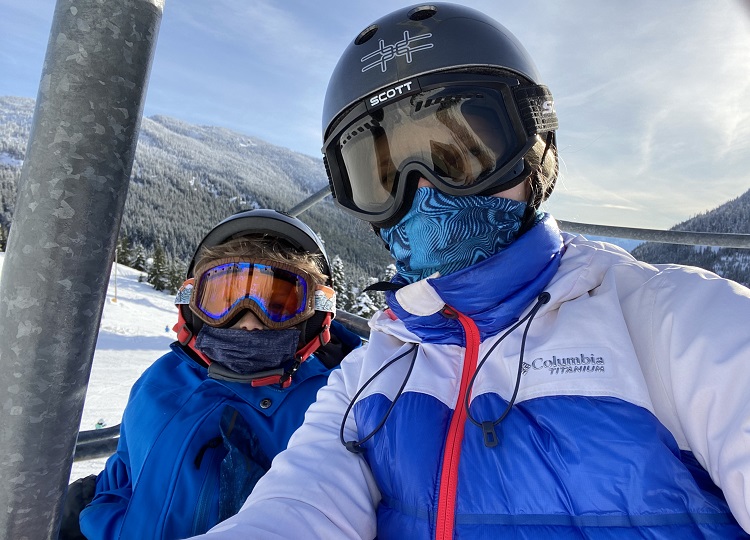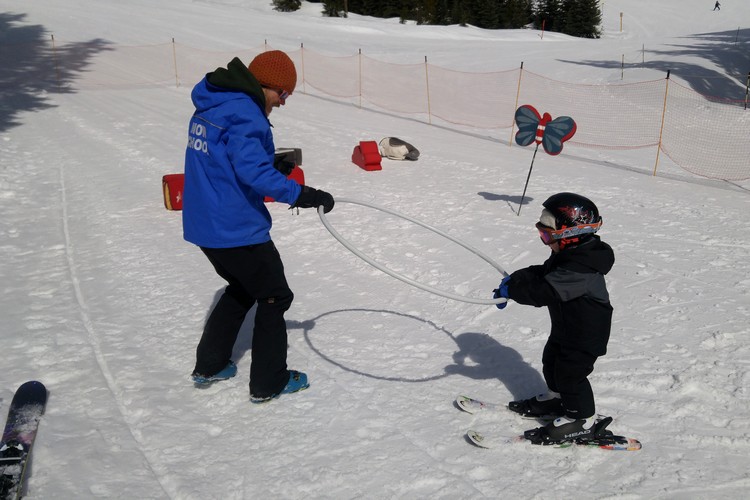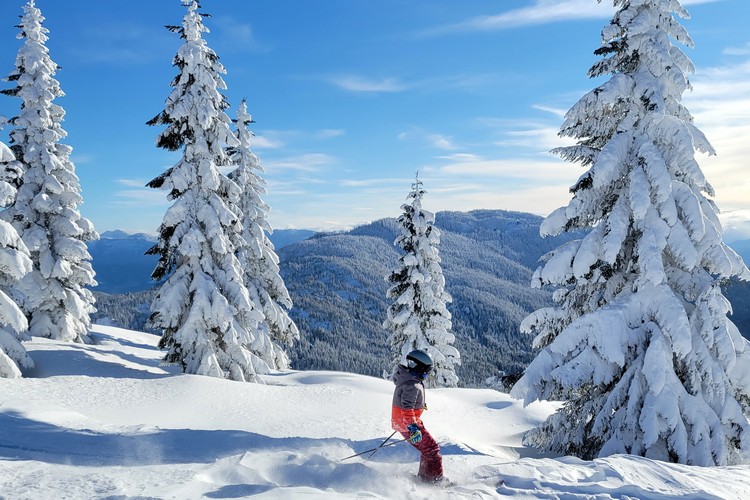Tips for teaching your kids to ski
If you’ve been following this family travel blog over the years, you will notice a theme each winter. Our Facebook page and Instagram stories begin to fill with videos and photos of us skiing and snowboarding. Many of you have reached out asking for tips to teach your kids to ski.
In this blog post, we answer that question and share some tips to help you teach your kids to ski.
Both of our boys continue to improve their skills each year. They’re gaining confidence and choosing to push themselves every day, which has been a fun and rewarding experience.
We’re happy to report that we now ski together as a family.
However, it’s important to note that this did not happen overnight. Quite the opposite, actually. We’ve invested a lot of time, energy and money to get here.
There were many moments when we wanted to throw our gloves up in the air and say, “Fine! Let’s go home then!”
If you have kids learning to ski or snowboard, you’ve likely experienced similar moments. It can be frustrating.
Why teach your kids to ski?
We have always enjoyed our time at ski resorts. We love the ski culture.
Every day on the mountain is different, which is what keeps us coming back for more.
Neither of us learned to ski at a young age. It wasn’t until our teenage years that we discovered our passion for snowboarding. Over the years, we’ve visited many ski resorts in British Columbia. We also spent one winter snowboarding in the French Alps.
We’ve made it a priority to introduce our boys to skiing at a young age so they can develop their skills early. Skiing is such a great sport and we hope they embrace it as they get older.
In other news, we bought a cabin at Sasquatch Mountain! That’s another reason why we want our kids to embrace winter sports.
Our oldest boy, Braydon (above), first learned to ski at Sun Peaks Resort, located near Kamloops in British Columbia. He was 4 years old at the time.
Read about that experience here.
Connor, our youngest boy, first learned to ski at Manning Park Ski Resort. He was 3 years old at the time.
Tips for teaching your kids to ski
Let me begin by pointing out that we do not ski. We snowboard.
Therefore, these ski tips for kids are not about technical skill development.
These simple tips for teaching your kids to ski are based on the lessons we learned on this journey to becoming a skiing/snowboarding family.
1. Start with skis first
Why did we put our boys on skis first, instead of snowboards?
It’s a good question, given that we both snowboard. However, we believe skiing is easier for kids to learn. Snowboarding requires a lot of balance and most beginners spend a lot of time catching an edge and falling. It can be frustrating.
The first goal is for them to learn about the mountain and how to use the chair lifts.
Had we put our boys on snowboards first, there’s a strong possibility they would have given up too soon.
However, this is our boys. It’s different for every child. You may find that your child prefers snowboarding.
2. Slow down. It’s not about you!
It’s natural to want your kids to love skiing or snowboarding as much as you do. But remember, it takes time.
Slow down and let your day on the slopes happen naturally. If you push too hard, you’re kids might have a negative experience.
Even if it’s a powder day or perfect bluebird conditions, let your kids dictate the pace. This may mean that you miss an epic day on the mountain because you’re spending time in the lodge drinking hot chocolate.
Remember – it’s not about you right now. Your time will come. Trust the process.
3. Consider putting your kid(s) in Ski School
Putting our boys in ski school was a game changer for us.
We found that our kids were much more responsive to ski instructors. Being in ski school allows them to connect and learn with their peers, which has a big impact on their confidence (it’s not so scary when the other kids are doing it, too).
Ski school also removes us from their learning process. This meant that our boys did not hear us correct them or tell them to do things differently (they get enough of that during every day life).
We put them in ski school at the beginning of the ski season. This gives them time to get familiar with the ski equipment and weather conditions. We chose multiple lessons that were scheduled close together (three consecutive days), in order to maximize their learning.
This worked well for us.
4. Let them decide the next step
We let our boys decide when they are ready for the next step. We’ve spent the entire ski season at Sasquatch Mountain Resort and the consistency has been good for Connor’s confidence.
He started the season at the Bigfoot Carpet lift, which is designated for beginners and first timers (see the chairlifts and runs here). Then he quickly moved to the Whistlepunk chair lift (also a beginners area) and spent the first month of the season there.
We asked him if he wanted to try the other chair lifts and he said he was NOT ready.
He later told us that he was ready to progress to the Green Chair. He went down a blue run that was a little steep for him. But he is proud of himself for taking the next step on his terms.
After that he returned to the familiar Whistlepunk chair lift area. That’s where he feels confident, so we let him decide.
Related – What you need to know about Sasquatch Mountain Resort
5. Age is just a number
Don’t worry about when other kids start skiing.
We put our boys on skis when they were both 4 years old. Some parents choose to start their kids skiing at 2 or 3 years old. Some wait until their kids are 10 years old.
You know your kid(s) better than anyone. Therefore, you decide when it’s the right time to teach your kids to ski.
The goal is to avoid tears, have fun and build their confidence on the mountain.
That said, if you plan to put your kid’s in ski school, it’s best that they are old enough to communicate with the ski instructor. This will increase the success of instruction for both the ski instructor and your child.
6. Start with Spring Skiing
Our boys tried skiing for the first time in the spring (late March).
We like spring skiing conditions and thought it would be the best time for our kids to start skiing. It was the right call, for a few of reasons.
First, spring skiing has soft snow (most of the time). This snow is more forgiving when you fall. Your kids will also naturally ski slower on the soft snow.
Second, spring skiing is warmer and it’s often sunny on the mountain. Our boys hate the cold. Avoiding sub-zero weather meant less layers and less frozen toes.
The warm weather and sunshine creates an easier learning environment.
Finally, you leave on a high. By starting in the spring, you will have a shorter first season. If all goes well, your kids will end the season feeling good about themselves.
Hopefully this translates into excitement for the next ski season.
7. Purchase your own ski equipment and gear
There is nothing worse than waiting in long lines to rent ski equipment.
This is especially true if you have impatient kids who are bundled up in warm winter gear. We’ve done it. It sucks.
Do yourself a favour and buy your kids’ ski equipment before heading up the mountain. This way, when you arrive at the mountain, you can go directly to the chair lifts.
It makes the experience much more enjoyable.
Purchasing your kids ski equipment is not as expensive as you may think.
When you factor in the cost and headache with renting equipment, it might actually be cheaper to buy your own equipment. Many ski resorts and rental shops will sell their used equipment shortly after the mountain closes for the summer.
You can also find used skis and equipment online. Facebook marketplace is a good place to start.
Also, keep an eye out for local ski swap programs. You will find great deals there.
Don’t worry about ski poles in the beginning.
If you’re kids are younger, ski poles might get in the way and create more challenges. Consider skipping the ski poles until they get more comfortable.
Related – The 6 best ski resorts near Vancouver BC
8. Get your family a Season Pass
Pick your mountain and get a Season Pass. Not only will you save a lot of money (depending on how often you go skiing with your kids), but you will have more flexibility.
Having a season pass should reduce stress and anxiety.
Why? Because when you have unlimited access to chair lifts, you can take each day as it comes. If you only spend a couple hours on the hill and the kids are tired, you can call it a day and head back early.
If the mountain has poor visibility or the ski conditions aren’t very good, you can just leave.
However, when you purchase single day passes it’s harder to leave if you’re not having a good time. You want to get your money’s worth, so you may find yourself pushing your kids too hard.
This has been a game changer for us. It removes the pressure of feeling like you have to spend X number of hours on the mountain because you spent X dollars on a day pass.
Visiting the same mountain also means getting familiar with the chair lifts and runs. The repetition helps with their confidence and comfort level. They start to know what to expect.
But be careful – getting a season pass might turn you into a snow snob! We may be guilty of skipping a few days on the mountain because the conditions weren’t to our liking.
9. Choose a Family Friendly Mountain
It’s important to pick a family friendly mountain when you teach your kids to ski.
We chose Sasquatch Mountain Resort for a few reasons:
- it has a lot of green (easy) runs
- the ski runs end at the same place – in front of the day lodge
- there are hardly any lines for the chairlifts
- day passes and season passes are reasonably priced
We also like that it has the Bigfoot Carpet (pictured below) for first time skiers. These carpets are much easier than the awkward T-bars or rope tows.
Sasquatch Mountain is known to get some of the most snow in southwest British Columbia. Soft snow is easier for kids to learn to ski. Our boys find it easier to turn and slow down on soft snow. And it doesn’t hurt as much if/when you fall.
Related – Everything you need to know about Sasquatch Mountain
10. Repetition develops skill and confidence
Practice makes perfect, as the saying goes.
Not every experience on the mountain is going to be positive. There will be bumps, bruises and frozen toes. But the more you commit to the learning process, the better the results will be.
It’s been very rewarding to watch our boys develop and push their comfort zone. As parents, we can’t think of a better outdoor family activity.
Are you planning to teach your kids to ski?
Share your tips and tricks in the comments below. We’d love to read them!





















Leave a Reply